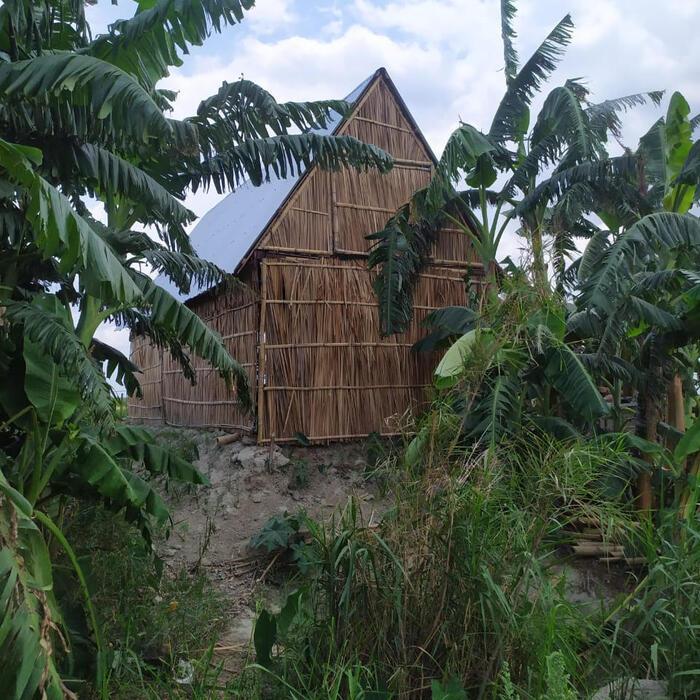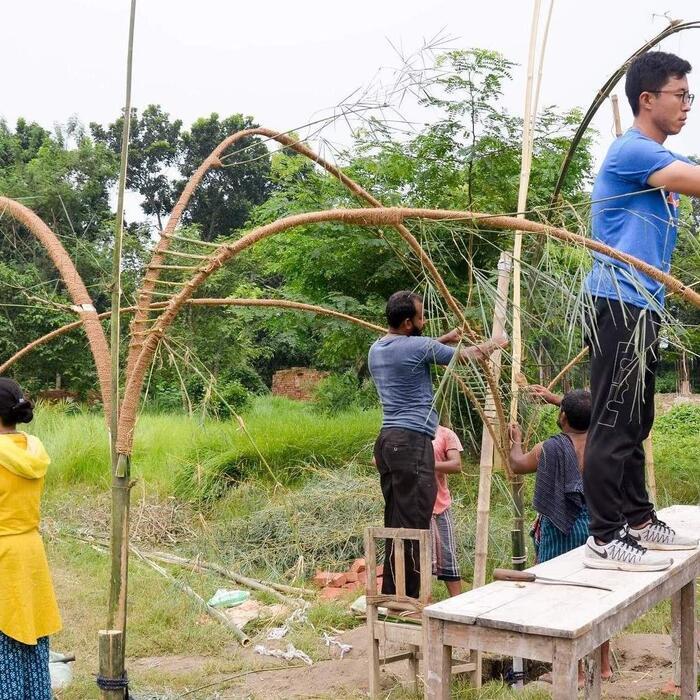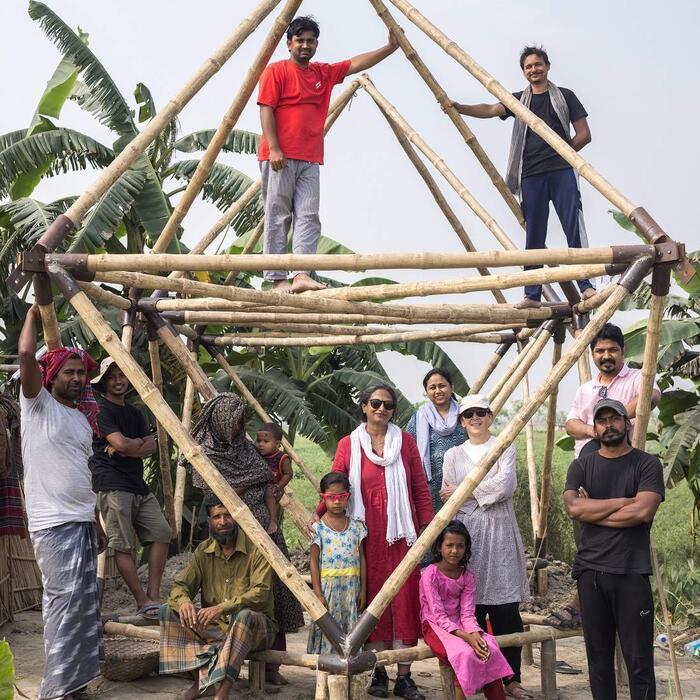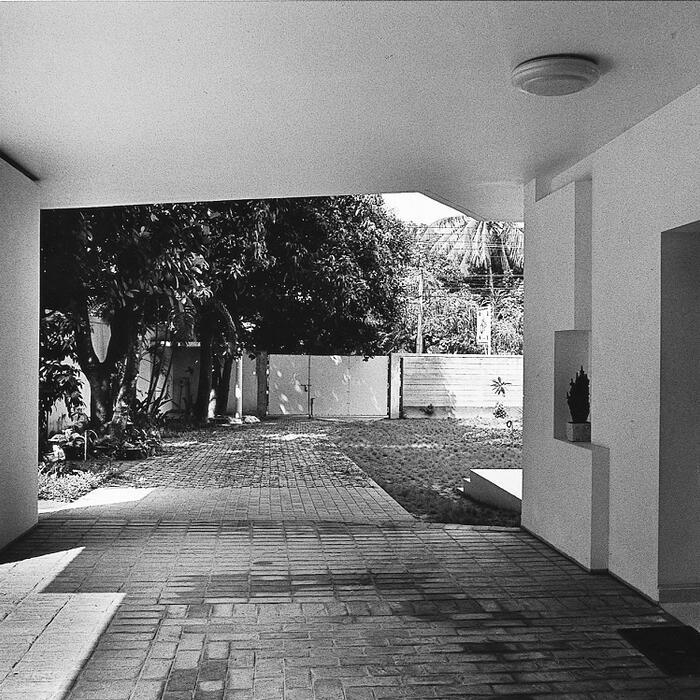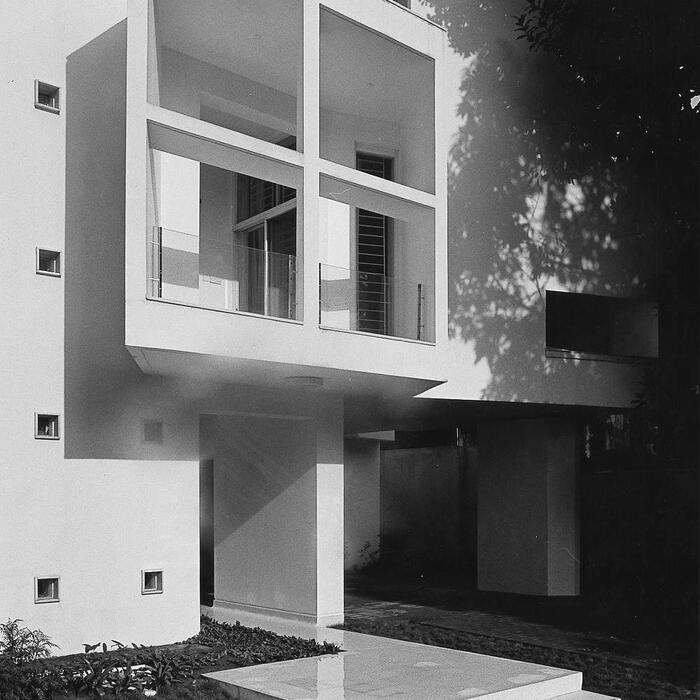Search results
Peter Buchanan Back to top
Notes on the architecture of Marina Tabassum
To appreciate Marina Tabassum’s architecture you must have some feeling for the sodden and unstable land that is Bangladesh. So, typically Marina opens lectures on her work with aerial photographs of Bangladesh. My memory is of a few exceptionally beautiful ones taken from high-up, which show a slowly shifting tapestry braided from water channels and emerald land that constantly move and interchange positions.
Then, coming into land at Dhaka, you see the river’s edges are lined with brick kilns and their tall smoke stacks, transforming soft grey mud into the pale red, fired brick necessary for stable construction. Although she used raw concrete for the Liberation War Museum and French German Embassy, her apartment blocks and towers are in this fairfaced and un-plastered brick – and exploit a stabilising and static four-square geometry as found in Islamic architecture. She continues to design in this fusion of abstract modernity and Islamic geometric discipline to invest her buildings with a calmly resonant dignity as found in the Baitur Rauf Mosque.
But Marina Tabassum is now also working with rural communities, adopting very pragmatic and contrasting formal and technical approaches to meet climatic and socio-economic challenges. The Khudi Bari project, for example, consists of a cheap, quickly assembled, modular and easily moved emergency relief dwellings for flood victims. Its triangulated bamboo frame can be clad in locally available materials, while its sheltered raised upper floor remains above flood levels.
For the 2019 Sharjah Triennial, she exhibited an equally pragmatic approach to low-cost housing, one familiar in parts of Bangladesh where it is a vernacular of its own. She simply purchased a pair of wood-framed and corrugated steel homes that local craftsmen assemble to be sold at the local markets. This expansion of service from architecture to activism, seems both the common-sensical (if also rare) caring for one’s fellows she modestly claims it to be, and it also continues a family tradition of community service. The land for the aforementioned mosque was donated by her grandmother; and her oncologist father not only founded a number of hospitals but at 84 years of age still does voluntary work seeing low-income patients in one of these hospitals.
Another scheme, the Panigram Resort, reworks an older vernacular of mud walls below a shaggy roof thatched from local vegetation. This is a scheme of comforting emotional appeal, its shaggy humped roofs embracing the sensually plastic mud walls and the raised platform that is the outdoor living room and centre of domestic life. The resort and its architecture capture something of the spirit of rural village life that enchanted so many worldwide in Satyajit Ray films such as Pather Pachali.
As well as designing the buildings and coordinating their construction, Marina worked with local craftspeople to revivify their products and marketing, and even helped introduce a form of community-based micro-finance. So, the resort doesn’t just serve more affluent visitors but has led to the regeneration of the community and expanded its livelihoods.
What I particularly applaud about these three community projects is that Marina has boldly transcended the constraining conservatism of conventional architectural taste that prefers the spare and abstract and is scared to touch anything populist. But to do so may be a necessary first step if architects are to serve and save an underappreciated and overexploited planet and its disaffected peoples.
Peter Buchanan worked for a decade as architect and urbanist in various parts of Africa, Europe and the Middle East. He then switched to writing about architecture and is a prolific author of articles and books. He also teaches the subject.
In the community Back to top
Our expert facilitators can provide a virtual experience of the Museum, bringing the Museum and its collection to life either through live streamed tours, or online presentations.
Online tours and presentations run on Tuesdays subject to availability. To find out more, or to book a session, email education@soane.org.uk.
Just Giving Back to top
The easiest way to give a donation is online, via our Just Giving page. Please remember to Gift-Aid your donation as it means we will receive an extra 25p for every £1 you give, at no extra cost to you.
Thank you so much for choosing to help the Museum. It’s only through the generosity of donors like you that we can continue our work.

Home Back to top
I am 52 years old. Unlike the giants who preceded me to this lectern, I consider myself a work in progress: the search is still on. The anxiousness of many years has evaporated with my turning fifty: choices made, roads taken; all leading me to a point of no return. This is not the time to reminisce on a past that could slow me down. This is the time to pour out all that was gathered over time, through relentless search, to contribute to the pursuit of architecture. The search never ends – it leads us to places, encounters, acquaintances and expanded horizons: sometimes to failures and realisations – but one must never arrive, arrival stops growth. There is still so much to learn, to realise, to develop.
I am in the middle of my journey. It is not time yet to look back and pick up the pieces to tell my tale. My stories and encounters are being collected and archived in my memory for the future. Someday, when I’m sitting on the porch of my farmhouse, which I’m yet to build, up in the north in Rohanpur, looking across the mango orchard and into the horizon, I will reminisce upon days gone by. I might then go back to the earliest memory of my life, to the sounds of destruction amidst Bangladesh’s liberation war in 1971. My story begins there, with my two-year-old self still holding on to the sadness of my grandfather’s passing in the middle of the war, watching from my grandparents’ house in Shantinagar as the police barrack in Rajar Bagh blazed with fire. The sirens and subsequent blackouts of air raids are still unsettling memories. I was introduced to death and destruction before I was enrolled in elementary school.
Growing up in the 70s – in a war-ravaged, fledgling nation of 70 million, full of uncertainties and minimal means – the children of my generation matured somewhat faster than usual. There were no toys to play with; and so we invented new games for ourselves. My childhood-self witnessed a country in a famine in 1974. Children of opulence will never know the power of imagination that can turn a rice ball into a boiled egg. I realised very early in life that limited means cannot limit dreams; these limits instead open the window of innovation. This lesson from my modest upbringing informs my work thus far.
Walls have two sides Back to top
The walls in my childhood had two sides. On one side was my grandparents’ property; a two-storey courtyard house secured with high walls: on the other side of the wall was the rickshaw pullers’ slum. The life of a child was dictated by which side of the wall he or she was born. On one side there was privilege, opportunity, aspiration; and on the other was struggle, and more struggle. We, children, played together in the field, unaware of the differences between us and how our beginnings would, in turn, impact our futures.
They didn’t go to school. We did. I was aware of the privilege we were born into. Unlike many, my family had the means to provide my siblings and me with a good education and opportunities for growth. I grew up in an environment where there was no discrimination between boy and girl. Even more fortunate, our parents instilled in us the importance and value of giving. My father being the only doctor in the neighbourhood, each morning we would wake up to a long line of patients from the neighbouring slum; he would attend to each one of them before setting off to work. In many ways, I seek to repeat that compassion through my architecture by expanding beyond the architectural programme, moving past the site boundary to attend to the human condition and the local ecology of sustenance. In this pursuit, I am trying to establish a sense of social and environmental responsibility that transcends architecture’s quintessential agenda of space and form.
Being a doctor, my father’s presence in our daily lives was periodic. Whereas my mother, a homemaker, invested all her time and energy in our upbringing, education being her priority. As the eldest of four children, I was her most important project. I must succeed in order for the rest to follow. During my school career – from primary years to graduating with an architecture degree – my mother was relentless and ever-present; providing everything that was humanly possible. She was successful in her pursuit that resulted in a doctor, an engineer and an architect before her passing in 2002.
Research Back to top
Our Research Library contains Soane’s collection of 30,000 architectural drawings and 10,000 books, along with a small working Library of modern books and information files on Soane, Robert Adam and other relevant architects. The Archive contains Soane’s business and personal papers. Students are welcome to consult this material by booking an appointment.
A Bengali, or a Bangladeshi? Back to top
Both my grandparents were immigrants. Their new life in Dhaka began after the partition of the subcontinent in 1947.
They were residents of Malda, a district now part of West Bengal. My father was ten years old when his family left home in the middle of the Hindu-Muslim riots. A base of a huka, intricately inlaid with silver, is the only physical memory that connects him to his home in Malda. He never found closure. He longed to go back home, but even though the nightmare of partition would end, he could not return to what was lost. Home became a longing, a story he would tell his grandchildren.
‘Desh’ refers to one’s origin, the village home. Locating ‘Desh’ is a shared quest, embedded in the culture of Bengalis. Throughout my growing years, I struggled with the answer.
For my family, and also for my generation, ‘Desh’ is no longer a place, but a story. A story of forceful uprooting, a story of leaving everything behind that our ancestors knew as home. A story of settling down and adjusting in a new territory. We, the third generation of an immigrant family, grew up with stories and mental constructs of a lost home that exists only in our imaginations.
Being born and brought up in the capital city of Dhaka, my connection to the villages were few and far between. The eternal beauty of the delta land revealed herself to me only in the last decade in various projects in the Ganges Delta. I found my ‘Desh’ there, through the interactions and connections I felt with rural Bengal, the soul of the delta land. There is inherent wisdom embedded in living symbiotically with nature. There, families do not aspire for their own dwellings to be different from their neighbours’; values are rooted in homogeneity and a communal way of life.
Architecture, a calling or an accident? Back to top
In a family of technocrats, it is taken for granted that one would either choose to be a doctor or an engineer. But I had a mind that sought freedom and could not be tamed by convention. My parents knew me well: my father suggested, ‘Why not architecture?’. In the late 80s, there was only one school – Bangladesh University of Engineering and Technology – that offered architecture courses to 50 students in a country of 12 million. The admission was tough and one had to sit for an entrance exam.
In light of this statistical unlikelihood, an architecture student was appointed to impart the basic knowledge of composition and design that I might go on to study. I felt an immediate connection to architecture, a sense of discovery and freedom that turned into a strong determination; a journey that began for me in 1989. Even in the 80s, the profession of architecture was fairly new in Bangladesh and was still struggling to establish a place beside an engineer-dominated construction industry. The architecture school was set up in 1962 with a grant from the Ford Foundation. Richard Vrooman (a professor from Texas A&M University) was the first dean. The curriculum that was set up in the 60s continued in the late 80s; a heavy dose of modernism at a time when the postmodern movement had taken root in the West. We, students, learnt to dislike ornament and adore form-finished concrete. In a pre-internet era, our only window to the world beyond Bangladesh was through books in the university library; we dutifully spent long hours admiring the works of the modern architectural masters of the twentieth century. I particularly enjoyed a book on Luis Barragán that instilled in me a longing to visit Mexico. But the book I repeatedly returned to for inspiration was a volume on the New York Five; these maverick architects and their buildings were as exciting to me as Coca Cola.
My biggest takeaway from school now, is the backpacking trips I took with friends through the subcontinent, from Ajanta to Elora to Fatehpur Sikri, my peers and I exploring the richness of our own history. Those of us who grew up outside of the West – yet with every aspect of our upbringing influenced by Western thinking – grew up quite confused. Self-esteem was low growing up in a country ravaged by war and poverty, and challenged climatically and politically. Few talked about patriotism while growing up in the eighties. Some of us learnt to reject our own context and aspired for a life in the West; many of my friends responded to that calling and left for good. There were also a few amongst us who aspired to retain cultural integrity by embracing localness. I am a firm believer in mediation and sought balance through negotiation. I sought to root myself as much as I aspired to explore.
Light Back to top
The parliament complex by Louis Kahn is a much-revered building in Bangladesh and it was ritualistic for architecture students to visit the complex with our professors. The ambulatory is the urban street that connects eight building blocks to the central chamber: the street is a room lit by sunlight filtering through glass bricks embedded in the roof. The brightness of the direct sun filtering through the ceiling bricks reveals the dramatic play of light and shadow. As the clouds cover the sun, the light inside the ambulatory softens, giving way to a sombre mood. How the atmosphere inside a building, in this building, could change with the movement of the sun and clouds was my first lesson in daylight.
Kahn occupies a place next to the gods in Dhaka’s architectural realm. Like the rest, I learnt to worship him. First blindly, without fully comprehending why; later through appreciation and reverence. The magic and harnessed power of light that I first experienced in the ambulatory of the parliament building became a relentless search for the spirit of architecture, a spirit that is an extension of us. A building is an entity that enters into silent dialogue with the dweller. Together they create memories, share stories, shaping and aging together. At times a building can teach us more about architecture than schools can; the parliament building of Bangladesh is one such building
The spirit of place Back to top
Architecture has given me more than I had anticipated. A few choices made very early in my journey defined my practice over the years. When I graduated from architecture school in 1995, the affliction of consumer architecture had already infested the city of Dhaka. Architecture practices based in Bangladesh, as elsewhere in the world, were busy designing multi-tiered, residential and commercial blocks ready for sale. A generation of fast-bred buildings, primarily focused on profitability, sprung up in the blink of an eye and the sad cry of destruction from the older fabric of the city was overpowered by the cacophony of the arrival of the new.
The first confrontation of my professional life was coupled with the commodification of architecture, as I witnessed the global tendency toward instant gratification and industrially produced anthropogenic materials devised to standardise the entire globe. The quest for my own identity – my ‘Desh’, that which I had sought since my childhood – seemed diluted within high-flying capitalist culture. The icon-mania of the super-rich and stardom of architects brought about a crisis. It is a point of crisis when an architect must decide whether to indulge in easy excitement or to choose a path of resistance.
I chose to resist, to deny temptation and to search within; within the land I grew up in, the place and country I call home.
The fragile delta – where no one knows where water ends and land begins – exhibits a magical chemistry embedded in the psyche of its local people, their life and living. The abundance of rain is a blessing in monsoon season, while the dry days of winter are quiet breaks. The earth is generous, vegetation lush and the history rich. The spirit of the Delta offers insight into a unique material palette defined by climate, location, culture and history; and yet the spirit of time draws attention to the evolutionary nature of a socio-economic-cultural atmosphere that is in constant flux. Muzharul Islam, the first Bengali architect of Bangladesh, my mentor and guide, stressed on rootedness in order to produce a work of architecture that is an offering to this matrix of people, place, time and context.

